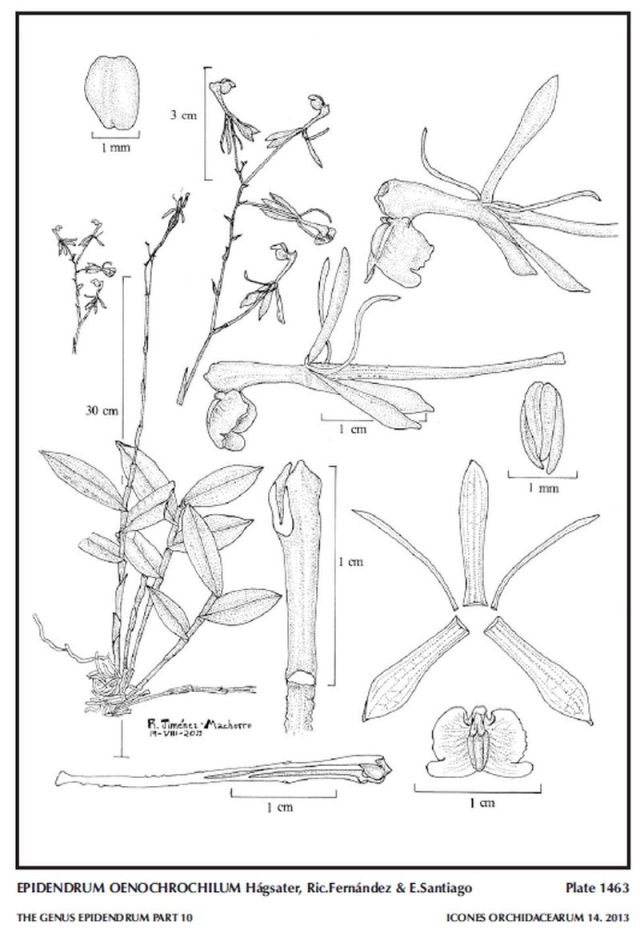

Epidendrum oenochrochilum Hágsater, Ric.Fernández & E.Santiago 2013 GROUP Psuedepidendrum SUBGROUP Pluriracemosum
TYPE Drawing by © Jimenez and The AMO Herbaria Website





Common Name The Wine Colored Lip Epidendrum
Flower Size .8” [2 cm]
Found in the departments of San Martin, Huanuco and Junin, Peru at elevations around 1000 meters as a small sized, warm to cool growing, caespitose epiphyte with simple, cane-like, terete, suberect, straight stems carrying 6 to 8 all along the apical 2/3rds of the stem, articulate, alternate, coriaceous, dark green dorsally tinged with dark purple, elliptic, acute, margin entire, spreading, abaxially dark green, adaxially purple leaves that blooms in the fall and winter on a terminal, arising as a raceme, in time a new raceme arises from the same peduncle in successive years, then pluriracmose, suberect, peduncle 6.4 to 8” [16 to 20 cm] long, thin, somewhat laterally compressed, straight, provided with 5 to 7 tubular, acute bracts, decreasing in size towards the apex, rachis 3.2 to 4.4" [8 to 11 cm] long, thin, laterally compressed, generally with 1 to 2, short, racemse, laxly, sucessively 17 to 20 flowered inflorescence with shorter than the ovary, triangular, acuminate, amplexicaul floral bracts and carrying disorderly resupinate flowers with the sepals purple brown dorsally, greenish purple internally, the petals purple, the lip yellow brown to dirty pink with the disc pale yellow including the calli and the keels, the base of the column is green and the apex is white.
"Epidendrum oenochrochilum belongs to the GROUP Psuedepidendrum which is characterized by caespitose plants, canelike stems, acute to acuminate leaves, usually apical inflorescence, the mostly filiform petals and the lip usually 3-lobed with 3 parallel fleshy keels, the apical lobe often bifurcate, the “bird-wing” type pollinia, at least the inner pair, and the SUBGROUP Pluriracemosum which has a racemose and few-flowered inflorescence on an elongate peduncle, usually producing new racemes over the years and thus pluri-racemose, the rachis is elongate, and thus lax flowered, the flowers bicolored, basically green to brown with the lip white to purple, spotted or not. The species is recognized by the 16 to 20" [40 to 50 cm] tall plants, with short 1.12 to 2.6" [2.8 to 6.5 cm] long elliptic leaves; an elongate inflorescence, with successive flowers, several open at one time, the peduncle of the inflorescence with 5 to 7 tubular bracts, sepals .56 to .6" [14 to 15 mm] long greenish purple, and especially the lip yellow-brown to dirty pink with the disc pale yellow (including the calli and keels). The Central American Epidendrum turialvae Rchb.f. has linear-lanceolate leaves .28 to 7.4" [7 to 18.5 cm] long, ventrally tinged purple, the inflorescence sub-corymbose, with greenish flowers, the disc occasionally tinged with purple. Epidendrum rodrigoi Hágsater (endemic to Colombia) has elliptic-lanceolate leaves, ventrally tinged purple, 4 to 4.8" [10 to 12 cm] long, the inflorescence with 3 to 7 olive-green flowers, the lip pink. Epidendrum pluriracemosum Hágsater & E.Santiago, known only from the French Guyana has similar plants with concolor, longer leaves 1.2 to 6.4" [3 to 16 cm] long, a reduced peduncle with 1 to 2 tubular bracts, and the somewhat smaller flowers with sepals .36 to .42" [9 to 10.5 mm] long, green with a white lip. Epidendrum huamantupanorum Hágsater & E. Santiago has narrowly elliptic leaves 1.4 to 5.2" [3.5 to 13 cm] long, copper-green flowers the lip hyaline white with the calli and ribs lavender, surrounded by a ring of darker lavender." Hagsater etal 2013
Synonyms
References W3 Tropicos, Kew Monocot list , IPNI ; Icones Orchidacearum 14 Plate 1440 Hagsater & Santiago 2013 See recognition section; * Icones Orchidacearum 14 Plate 1463 Hagsater, Ric.Fernández & Santiago 2013 drawing fide; Icones Orchidacearum 14 Plate 1476 Hagsater & Sanchez 2013 see recognition section;Icones Orchidacearum 14 Plate 1492 Hagsater & Santiago 2013 See recognition section; Orquideas, Tesoro de Colombia Vol 2 Ortiz & Uribe 2017 as E aff oenochrochilum
--------------------------------------------------------------------------------------------------------------------------